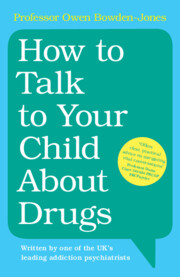Book contents
- How to Talk to Your Child About Drugs
- How to Talk to Your Child About Drugs
- Copyright page
- Contents
- Acknowledgements
- Introduction
- 1 What Are Psychoactive Drugs, Who Uses Them and Why?
- 2 Understanding Adolescence
- 3 Having the Drug Conversation with Your Child
- 4 Drugs and the Brain
- 5 How Do Drugs Cause Harm?
- 6 Types of Drugs
- 7 Rise of the Synthetics
- 8 Legal but Harmful: Prescription Medications, Tobacco, Vaping and Alcohol
- 9 Behavioural Addictions
- 10 Detecting Drug Use and What to Do about It
- 11 Treatment and Recovery
- 12 Final Thoughts
- Useful Resources
- References
- Index
2 - Understanding Adolescence
Published online by Cambridge University Press: 13 February 2025
- How to Talk to Your Child About Drugs
- How to Talk to Your Child About Drugs
- Copyright page
- Contents
- Acknowledgements
- Introduction
- 1 What Are Psychoactive Drugs, Who Uses Them and Why?
- 2 Understanding Adolescence
- 3 Having the Drug Conversation with Your Child
- 4 Drugs and the Brain
- 5 How Do Drugs Cause Harm?
- 6 Types of Drugs
- 7 Rise of the Synthetics
- 8 Legal but Harmful: Prescription Medications, Tobacco, Vaping and Alcohol
- 9 Behavioural Addictions
- 10 Detecting Drug Use and What to Do about It
- 11 Treatment and Recovery
- 12 Final Thoughts
- Useful Resources
- References
- Index
Summary
Adolescence is the period between the onset of puberty and the point at which adult roles are assumed and involves rapid physical, psychological and social change.
In adolescence, learning takes place as the brain establishes neural networks. These networks are constantly modified by new experiences.
The adolescent brain develops in stages. One of the last areas to develop are the frontal lobes, the part of the brain responsible for decision-making and assessing risk.
Just when the adolescent brain is at this delicate developmental phase, it is also most impulsive and drug use is most likely.
Drug use in adolescence disrupts brain development, which can lead to long-term damage to brain function and increase the risk of further drug use.
Many adolescents are surprisingly poorly informed about drugs, their effects and the harms they can cause.
Adolescents tend to seek information about drugs from the internet or friends.
Accurate information is available and should be highlighted to adolescents.
- Type
- Chapter
- Information
- How to Talk to Your Child About Drugs , pp. 24 - 35Publisher: Cambridge University PressPrint publication year: 2025

